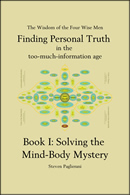This Site is Based on Fractals
In case you haven't noticed, everything on this site is based on fractals. From the simple mental patterns underlying wounds and healing to an entire personality theory and a new scientific method, nothing is linear. The thing is, if you research the fractal, you'll find a lot of very bright scientists talking about them, but strangely not one of these people offers a scientific definition of this word. This includes the brilliant scientist who coined this word, Benoit Mandelbrot, who defined fractals as "rough or fragmented geometric shapes that can be split into parts, each of which is (at least approximately) a reduced-size copy of the whole." Hardly a scientific definition.
What happens if you Google, "what are fractals?" When I did this, I found over four million answers. Amazingly, while many of these definitions offer beautiful detail, none of them agree. To their credit, most sites at least preface their offerings with an apology for their vague and nebulous definition.
This said, I find it hard to call these definitions, science. Real science is rooted in precise and clear definitions of both its descriptors and its methods. Or to be blunt, when it comes to science, words matter. For instance, by most scientist's definitions, both the Mandelbrot Set and Koch snowflakes are fractals. Yet even to the casual observation, the differences between linear and fractal things are obvious, including that nothing in the real world is linear.
Why is this relevant? Because science claims to be studying the nature of the real world. Theory is only an adjunct there to help along the way. Sadly science long ago seems to have forgotten—or deliberately abandoned—its mandate. If it hadn't, Mandelbrot Sets would be considered fractals while Koch snowflakes would not.
The following is a brief excerpt from my green book, Finding Personal Truth - Book I. In it, I address this problem.
A Few Words About the Word Fractal
Finally, for those scientifically minded folks who get set off when a person like me uses a word like fractal, please note that I define this word a bit differently. Moreover, true to the spirit of this book, I've spent more than a decade searching for a personally satisfying way to define this word. The result? Unlike the technically-minded complexity scientists who define this word more by what it does than by what it is (for instance, as a rough or fragmented geometric shape that can be split into parts, each of which is approximately a smaller copy of the whole), I use the manner favored by the ancient Greeks to define this word. I define it by its sine qua non—by it essence. Thus a fractal is a “recognizable pattern which always repeats differently.”
Why go through so much trouble to define the word fractal?
Traditional sciences see linear patterns as the only acceptable proof of truth. In other words, what proves something true to them is that the results repeat the same way every time. In effect, traditional sciences make outcomes such as impeccable logic or statistically meaningful repetitions their holy grail. Thus we can define the kind of truths they seek—linear truths—as “recognizable patterns which always repeat identically.”
Can you see the difference here? Recognizable patterns which always repeat differently (fractal truths) versus recognizable patterns which always repeat identically (linear truths). Fractal truths repeat differently. Linear truths repeat identically. Now recall that traditional sciences see linearity as the only acceptable truth. Unfortunately, while meaningful statistics and scientific logic obviously have their place, nothing in the real world is linear. Thus without fractal truths to counterbalance linear truths, our truths remain trapped inside the laboratory.
By juxtaposing linearity with fractility, however, we override this shortcoming. Fractility becomes the proof of truth in the real world, and linearity the proof of truth in theory. We also get a meaningful starting point from which to understand much of what we’ll be looking at in this series of books, including a way to see how theoretical and real world truths relate. In addition, we get a legitimately scientific way to define the nature of things, both linear and non linear alike. And we also get to understand the essence of what stumped as great a mind as Einstein—how uncertainty relates to certainty.
-
Inter-world fractals use logical geometry to define real world qualities, here the relationship between food temperature and overeating.
-
This fractal describes the formation of the layers of personality
-
This is the fractal underlying the reliving of all wounds
-
Psychophysical descriptors make the best fractals
Solving the Mind Body Mystery
A Foundation Course in Finding Personal Truth

Sometimes I think I should have titled this book, the science of words. In it I offer the first truly scientific definitions for the words facts and feelings. Unfortunately, like most of what I write, this book is as dense as lead. Admittedly, this makes it a tough read. But if you're serious about science, then you'll find this an interesting and surely challenging book.
Hardcover ($29.95)Also in eBook ($9.99) at:
Amazon | Barnes & Noble | Amazon UK

